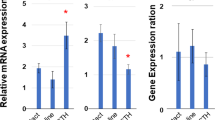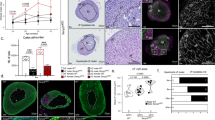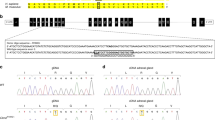Abstract
21-Hydroxylase deficiency, a potentially fatal disease due to deletions or mutations of the cytochrome P450 21-hydroxylase gene (CYP21), causes congenital adrenal hyperplasia (CAH) with low or absent glucocorticoid and mineralocorticoid production. The feasibility of gene therapy for CAH was studied using 21OH-deficient mice (21OH−) and a replication-deficient adenovirus containing the genomic sequence of human CYP21 (hAdCYP21). Intra-adrenal injection of hAdCYP21 in 21OH− mice induced hCYP21 mRNA with the highest expression from 2 to 7 days before a gradual decline. 21OH activity measured in adrenal tissue increased from undetectable to levels found in wild-type mice 2 to 7 days after AdhCYP21 injection. Adrenal morphology of 21OH− mice showed lack of zonation, and hypertrophy and hyperplasia of adrenocortical mitochondria with few tubulovesicular christae. These morphological abnormalities were markedly improved 7 days after hAdCYP21 gene therapy. Plasma corticosterone increased from undetectable levels to values similar in wild-type mice by 7 and 14 days, declining over the next 40 days. This is the first demonstration that a single intra-adrenal injection of an adenoviral vector encoding CYP21 can compensate for the biochemical, endocrine and histological alterations in 21OH-deficient mice, and shows that gene therapy could be a feasible option for treatment of CAH.
This is a preview of subscription content, access via your institution
Access options
Subscribe to this journal
Receive 12 print issues and online access
$259.00 per year
only $21.58 per issue
Buy this article
- Purchase on Springer Link
- Instant access to full article PDF
Prices may be subject to local taxes which are calculated during checkout



Similar content being viewed by others
References
New MI . Diagnosis and management of congenital adrenal hyperplasia Annu Rev Med 1998 49: 311–328
Pang S . Congenital adrenal hyperplasia Endocrinol Metab Clin N Am 1997 26: 853–889
Cutler GB Jr, Laue L . Congenital adrenal hyperplasia due to 21-hydroxylase deficiency New Engl J Med 1990 223: 1806–1813
Cutler GB Jr . Treatment of congenital adrenal hyperplasia: the case for new medical approaches J Clin Endocrinol Metab 1996 81: 3185–3186
Migeon CJ . Can the long range results of the treatment of congenital adrenal hyperplasia be improved? J Clin Endocr Metab 1996 81: 3187–3189
Shiroishi T, Sagai T, Natsume-Sakai S, Moriwaki K . Lethal deletion of the complement component C4 and steroid 21-hydroxylase genes in the mouse H-2 class III region caused by meiotic recombination Proc Natl Acad Sci USA 1987 84: 2819–2823
Gotoh H et al. Steroid 21-hydroxylase deficiency in mice Endocrinology 1988 123: 1923–1927
Robbins PD, Ghivizzani SC . Viral vectors for gene therapy Pharmacol Ther 1998 80: 35–47
Vincent N et al. Long term correction of mouse dystrophic degeneration by adenovirus-mediated transfer of a minidistrophin gene Nat Genet 1993 5: 130–134
Jaffe AH et al. Adenovirus-mediated in vivo gene transfer and expression in normal rat liver Nat Genet 1992 1: 372–378
Ye X et al. Prolonged metabolic correction in adult ornithine transcarbamylase-deficient mice with adenoviral vectors J Biol Chem 1996 271: 3639–3646
Ginsberg HS . The ups and downs of adenovirus vectors Bull NY Acad Med 1996 72: 53–58
Paltekian E et al. Adenovirus mediated gene transfer into the brain: methodological assessment J Neurosci Meth 1997 71: 77–84
Munch A, Guyre PM, Holbrook NJ . Physiological functions of glucocorticoids in stress and their relation to pharmacological action Endocrine Rev 1984 5: 25–44
Tajima T, Ma X-M, Bornstein SR, Aguilera G . Prenatal treatment does not prevent alterations of the hypothalamic pituitary adrenal axis in steroid 21-hydroxylase deficient mice Endocrinology 1999 140: 3354–3362
Geddes BJ et al. Persistent transgene expression in the hypothalamus following stereotaxic delivery of a recombinant adenovirus: suppression of the immune response with cyclosporin Endocrinology 1996 137: 5166–5169
Bornstein S et al. Adrenomedullary function is severely impaired in 21-hydroxylase deficient mice FASEB J 1999 13: 1185–1194
Bornstein SR et al. Ultrastructural dynamics of mitochondrial morphology in varying functional forms of human adrenal cortical carcinoma Horm Metab Res 1996 28: 177–182
Nussdorfer GG et al. Investigations on the turnover of adrenocortical mitochondria. XI A stereological study of the effects of chronic treatment with ACTH on the size and number of mitochondria from adult human adrenocortical cells cultured in vitro Cell Tissue Res 1977 182: 145–150
Bornstein SR, Ehrhart-Bornstein M, Guse-Behling H, Scherbaum WA . Structure and dymnamics of adrenal mitochondria following stimulation with corticotropin releasing hormone Anat Record 1997 234: 255–262
Okada T et al. Efficient directional cloning of recombinant adenovirus vectors using DNA–protein complex Nucleic Acids Res 1998 26: 1947–1950
Graham FL, Prevec L . Adenovirus based expression vectors and recombinant vaccines Biotechnology 1992 20: 363–390
McGrory WJ, Bautista DS, Graham FL . A simple technique for the rescue of early region I mutations into infectious human adenovirus type 5 Virology 1988 163: 614–617
Jones N, Shenk T . Isolation of adenovirus type 5 host range deletion mutants defective for transformation of rat embryo cells Cell 1979 17: 683–689
Smith TA et al. Adenovirus mediated expression of therapeutic plasma levels of human factor IX in mice Nat Genet 1993 5: 397–402
Stojilkovic SS, Chang JP, Ngo D, Catt KJ . Evidence for a role of protein kinase C in luteinizing hormone synthesis and secretion: impared responses to gonadotropin releasing hormone in protein kinase C depleted cells J Biol Chem 1988 263: 17307–17311
Fukushi M et al. A method for quantitative analysis of adrenal steroids with high-performance-liquid-chromatography for diagnosis of congenital adrenal hyperplasia. In: Therrel BL (ed) . Advances in Neonatal Screening Elsevier Science Publishers BV: New York 1987 303–308
Aguilera G, Lightman SL, Kiss A . Regulation of the hypothalamic-pituitary-adrenal axis during water deprivation Endocrinology 1993 132: 241–248
Author information
Authors and Affiliations
Rights and permissions
About this article
Cite this article
Tajima, T., Okada, T., Ma, XM. et al. Restoration of adrenal steroidogenesis by adenovirus-mediated transfer of human cytochromeP450 21-hydroxylase into the adrenal gland of21-hydroxylase-deficient mice. Gene Ther 6, 1898–1903 (1999). https://doi.org/10.1038/sj.gt.3301018
Received:
Accepted:
Published:
Issue Date:
DOI: https://doi.org/10.1038/sj.gt.3301018
Keywords
This article is cited by
-
Cost-effective genotyping for classical congenital adrenal hyperplasia (CAH) due to 21-hydroxylase deficiency (21-OHD) in resource-poor settings: multiplex ligation probe amplification (MLPA) with/without sequential next-generation sequencing (NGS)
Hormones (2023)
-
Management challenges and therapeutic advances in congenital adrenal hyperplasia
Nature Reviews Endocrinology (2022)
-
Neue Behandlungsstrategien bei adrenogenitalem Syndrom/21‑Hydroxylase-Mangel
Journal für Klinische Endokrinologie und Stoffwechsel (2022)
-
Novel treatments for congenital adrenal hyperplasia
Reviews in Endocrine and Metabolic Disorders (2022)
-
An AAVrh10-CAG-CYP21-HA vector allows persistent correction of 21-hydroxylase deficiency in a Cyp21−/− mouse model
Gene Therapy (2017)



